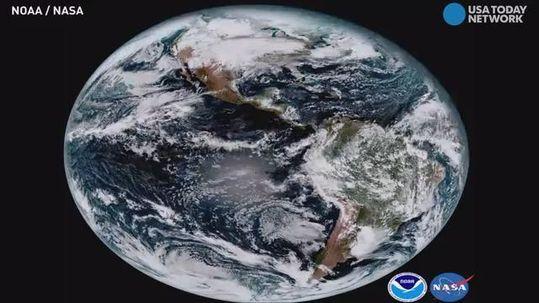The USA’s newest weather satellite sends first photos. Think ‘hi-def from the heavens’

The GOES-16 satellite has captured breathtaking images of our planet with such detail that it will help experts provide more accurate severe weather predictions. USA TODAY NETWORK
The USA’s newest weather satellite — GOES-16 — has sent back its first images of our planet, federal scientists announced Monday.
The photos are of weather and the Earth in high detail — at four times the image resolution of existing spacecraft. It’s like “high-definition from the heavens,” the National Oceanic and Atmospheric Administration said in a statement.
GOES stands for geostationary operational environmental satellite.
“This is such an exciting day for NOAA,” said Stephen Volz, the director of NOAA’s Satellite and Information Service. “One of our GOES-16 scientists compared this to seeing a newborn baby’s first pictures — it’s that exciting for us.
“These images come from the most sophisticated technology ever flown in space to predict severe weather on Earth,” he said.
And it’s fast: The satellite can scan the entire Western Hemisphere in just five minutes. “It will revolutionize how severe weather forecasting is done,” said meteorologist Ryan Maue of WeatherBell Analytics.
The school-bus-size satellite, known as “GOES-R” when it launched in November and now by its new name “GOES-16,” is in a “geosynchronous” orbit of the Earth. This means it hovers in the same spot above the planet, about 22,000 miles above the equator. It moves as the Earth rotates.
In May, NOAA will announce the final planned location for GOES-16. By November 2017, GOES-16 will be operational as either GOES-East or GOES-West.
NOAA will use the satellite’s six new instruments to generate new or improved meteorological, solar and space weather products.
References
- ^ 1 of 10 (rssfeeds.usatoday.com)
- ^ 2 of 10 (rssfeeds.usatoday.com)
- ^ 3 of 10 (rssfeeds.usatoday.com)
- ^ 4 of 10 (rssfeeds.usatoday.com)
- ^ 5 of 10 (rssfeeds.usatoday.com)
- ^ 6 of 10 (rssfeeds.usatoday.com)
- ^ 7 of 10 (rssfeeds.usatoday.com)
- ^ 8 of 10 (rssfeeds.usatoday.com)
- ^ 9 of 10 (rssfeeds.usatoday.com)
- ^ 10 of 10 (rssfeeds.usatoday.com)








